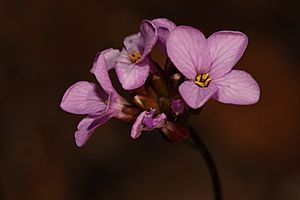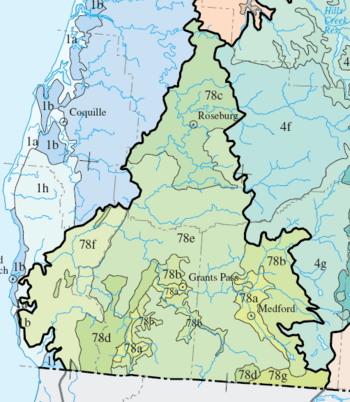Klamath Mountains (ecoregion) facts for kids
Quick facts for kids Klamath Mountains |
|
|---|---|

Bear Mountain in the Siskiyou Wilderness of California
|
|
 |
|
| Ecology | |
| Realm | Nearctic |
| Biome | Temperate coniferous forests |
| Borders |
List
|
| Bird species | 220 |
| Mammal species | 87 |
| Geography | |
| Area | 50,245 km2 (19,400 sq mi) |
| Country | United States |
| States | California and Oregon |
| Coordinates | 41°30′N 123°18′W / 41.5°N 123.3°W |
| Conservation | |
| Conservation status | Critical/Endangered |
| Global 200 | Yes |
| Habitat loss | 4.4045% |
| Protected | 56.99% |
The Klamath Mountains ecoregion is a special natural area in Oregon and California. It's located inland, north of the Coast Range. This region stretches from the Umpqua River in the north all the way to the Sacramento Valley in the south.
This ecoregion includes the many hills, valleys, and ridges of the Klamath Mountains and Siskiyou Mountains. It's known by different names, like the "Klamath-Siskiyou forests ecoregion" by the World Wide Fund for Nature.
This area was not covered by glaciers during the last Ice Age (the Pleistocene epoch). Because of this, it became a safe place for many northern plant species to survive. The rocks here are a mix of granite, sedimentary, and metamorphic types. This is different from the volcanic rocks found in the Cascades ecoregion nearby. The climate is mild and a bit humid, with long, dry summers. This weather helps a mix of northern Californian and Pacific Northwestern conifer (cone-bearing) and hardwood trees grow here.
Contents
Amazing Plants and Animals
The Klamath Mountains ecoregion is super rich in biodiversity, meaning it has a huge variety of life! You can find many different plant communities here, like temperate rain forests, moist inland forests, oak forests, and even high-up alpine grasslands.
This region is home to 30 different kinds of conifer trees. Seven of these are endemic, which means they are found nowhere else in the world! This makes the Klamath Mountains one of the most diverse conifer forest regions on Earth. The area also has special plant communities that grow only on certain soil types, especially on serpentine soils.
Some of the cool conifer trees you can find here include:
- Coast Douglas-fir
- Lawson's Cypress (also called Port Orford Cedar)
- Ponderosa Pine
- Sugar Pine
- Mountain Hemlock
- White Fir
- Red Fir
- Weeping Spruce
- Coast Redwood
- Pacific Yew
The California Buckeye tree also reaches its northernmost limit here.
Different Areas of the Klamath Mountains
The Klamath Mountains ecoregion is so big and diverse that scientists have divided it into smaller parts, especially in Oregon. These are called "Level IV ecoregions." Let's explore some of them!
Rogue/Illinois Valleys
This area includes the flat lands and riverbanks of the Rogue and Illinois river valleys. It's about 900 to 2,000 feet (274 to 610 meters) above sea level. Long ago, these valleys had Oregon white oak and California black oak woodlands, along with ponderosa pine and grasslands.
Today, much of this land is used for farms or homes. Not much of the original plant life is left. You can still find some oak savanna and prairie plants on the flat tops of the Table Rocks near Medford. This area feels more like the inland valleys of Northern California than the Willamette Valley to the north.
Oak Savanna Foothills
These are the gently sloping hills next to the Rogue and Illinois river valleys. They have a Mediterranean climate, meaning warm, dry summers and mild, wet winters. The elevation here is between 1,400 and 4,000 feet (427 to 1,219 meters).
The driest parts, east of Medford, have Oregon white oak, California black oak, grasslands, and ponderosa pine. The wetter hills near the Illinois Valley have Douglas-fir and California incense-cedar. You might also see oceanspray, Western poison-oak, and snowberry plants.
Umpqua Interior Foothills
This ecoregion is a mix of hills and narrow valleys. It's drier than the Willamette Valley to the north because the summer dry season starts earlier and lasts longer. Summers are hot and dry.
The slopes here are covered with Oregon white oak, Douglas-fir, grand fir, ponderosa pine, and tanoak. There's also a chaparral (shrubland) community with snowberry, salal, Oregon grape, and swordfern. Many areas have been turned into pastureland, vineyards, and orchards. This area includes the city of Roseburg.
Serpentine Siskiyous

This area has steep mountains with fast-flowing streams, from 1,500 to 4,300 feet (457 to 1,311 meters) high. What makes it special is its serpentine soil. Many plants find it hard to grow here because the soil has too little calcium and too much magnesium, nickel, and chromium.
Because of this, the plants that grow here are often special types that have learned to live in these tough conditions. You'll find a mix of Jeffrey pine, tanoak, incense-cedar, and Douglas-fir. There's also a montane (mountain) chaparral with manzanita and ceanothus. This region has a history of mining for gold, nickel, and other metals, which has sometimes caused water quality problems.
Inland Siskiyous

This ecoregion is higher and more mountainous than the nearby valleys and foothills, ranging from 800 to 7,000 feet (244 to 2,134 meters). It has more wildfires, less rain, and longer summer droughts than the Coastal Siskiyous.
The forests here are very diverse, with many layers of conifers, broadleaf evergreen trees, and deciduous (leaf-shedding) trees and shrubs. You'll see Douglas-fir, ponderosa pine, Oregon white oak, California black oak, and snowberry. This is the largest part of the Klamath Mountains mapped in Oregon so far.
Coastal Siskiyous
This area has very steep mountains and a wetter, milder maritime climate because it's closer to the ocean. Elevations range from 600 to 5,300 feet (183 to 1,615 meters).
The forests here are very productive, with tanoak, Douglas-fir, bigleaf maple, California laurel, and some Port Orford cedar. If an area is disturbed, broadleaf evergreen trees like tanoak and madrone quickly grow back, making it hard for conifer forests to regrow. This region includes parts of the Rogue River – Siskiyou National Forest and the Kalmiopsis and Wild Rogue wilderness areas.
Klamath River Ridges
The Klamath River Ridges are steep mountains with a dry, continental climate. They are quite high, from 3,800 to 7,500 feet (1,158 to 2,286 meters). The plants here change depending on the slope, which way it faces (north or south), and how high up it is.
Higher areas and north-facing slopes have Douglas-fir and white fir. Lower areas and south-facing slopes have ponderosa pine and western juniper. These trees are better at handling dry conditions. The chaparral (shrubland) here includes Oregon grape, snowberry, and ceanothus. This region is near the Siskiyou Summit.


